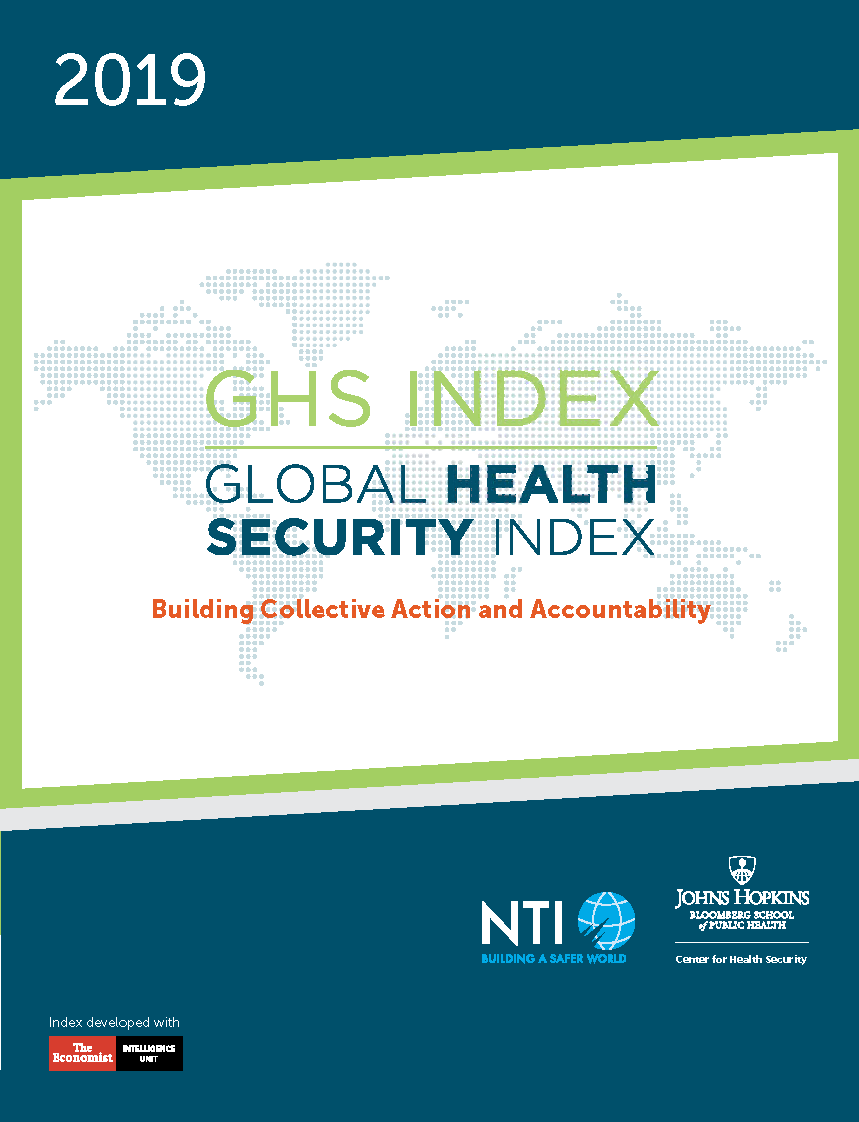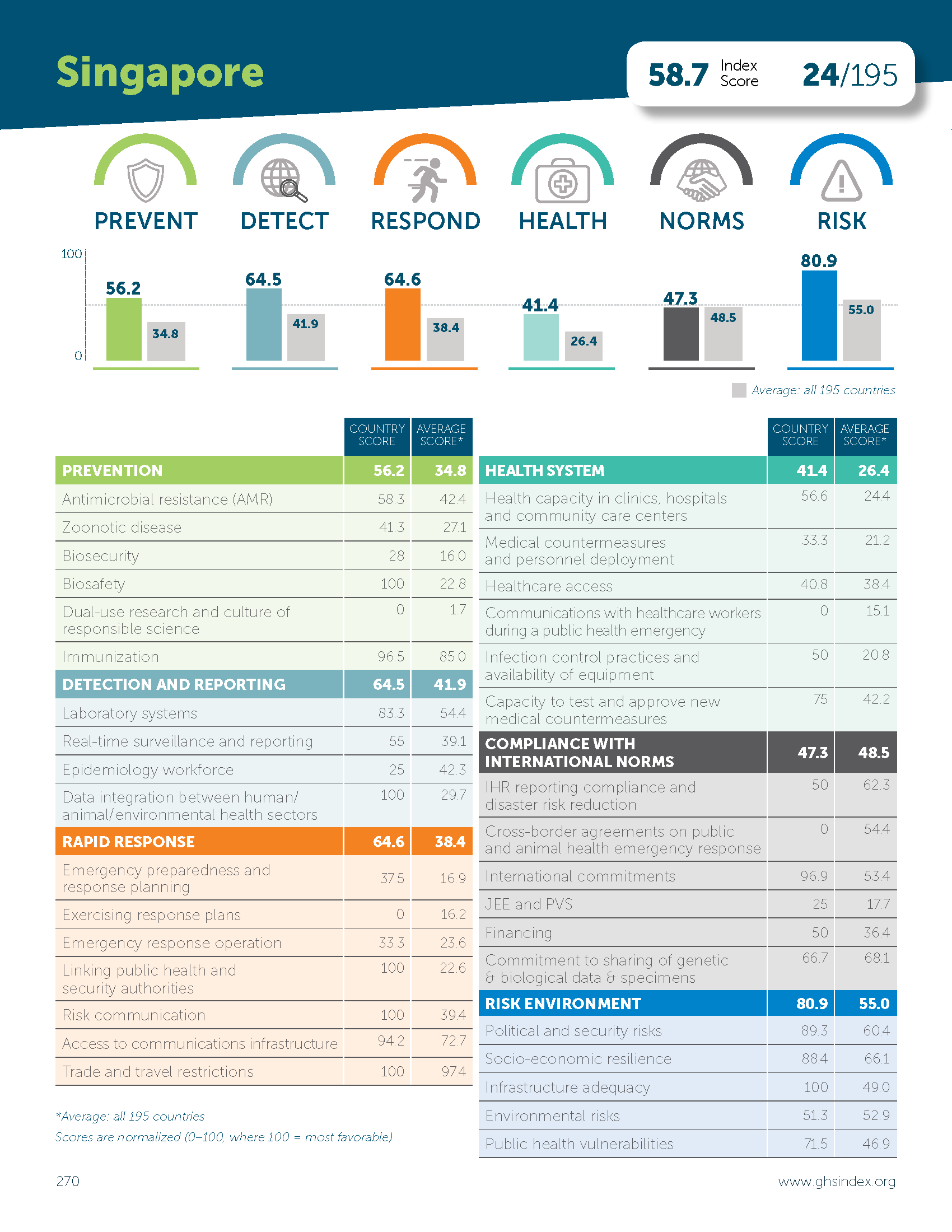Beyond a Scorecard Index:
Relooking Singapore’s Global Health Security
An SSHSPH Perspective piece by Associate Professor Hsu Li Yang and Associate Professor Jeremy Lim, Co-Directors of LIGHT.
Published 15 November 2019
The inaugural Global Health Security Index (GHSI) released last month, ranked Singapore a disappointing 24th out of 195 countries evaluated for their overall preparedness for infectious disease outbreaks and pandemics. In comparison, neighbouring ASEAN countries such as Thailand (6th) and Malaysia (18th) have scored better.
This happened in part because Singapore scored zero out of a possible hundred in four of 34 categories: ‘Dual use research and culture of responsible science’ (i.e., life sciences research with results that could be misapplied to creating public health and safety threats), ‘Exercising response plans’, ‘Communications with healthcare workers during a public health emergency’, and ‘Cross-border agreements on public and animal health emergency response’.
This surprised and perhaps even alarmed some in Singapore and internationally, but as we explain in this piece, the methodological approach disadvantaged Singapore. Singaporeans should not be concerned about the adequacy of Singapore’s bio-defences; there are areas for improvement raised in the GHSI which Singapore should focus on but the national frameworks are overall robust.
Singapore’s track record in global health security
The relatively poor ranking caught public health professionals by surprise, not least because Singapore has successfully weathered her share of infectious disease outbreaks, ranging from SARS in 2003, pandemic influenza H1N1 in 2009, Zika in 2016, and even an imported monkeypox case in 2019.
Furthermore, the World Health Organization (WHO) had praised Singapore’s high level of transparency and swift handling of the Zika outbreak in 2016, and as recently as last year, its multisectoral Joint External Evaluation (JEE) team of international experts — that spent 5 days in Singapore in April 2018 reviewing the country’s core capacities for meeting the International Health Regulations (IHR) — had unanimously concluded that Singapore demonstrates a high level of achievement in fulfilling IHR requirements. Specifically, ‘strong leadership and a highly developed capacity to detect and respond to potential public health emergencies’, including infectious disease outbreaks, were singled out as noteworthy.
Why the poor scores then?
The GHSI, a joint project of Nuclear Threat Initiative and the Johns Hopkins Center for Health Security — US-based non-profit organisations invested in strengthening global security — with research performed by the Economist Intelligence Unit (EIU), used only open source data for analyses. This was by design: the Index “was created in this way with a firm belief that all countries are safer and more secure when their populations are able to access information about their country’s existing capacities and plans and when countries understand each other’s gaps in epidemic and pandemic preparedness so they can take concrete steps to finance and fill them”.
However, the ‘absence of evidence’ is certainly not ‘evidence of absence’. There might have been policies and regulations related to biosecurity that are not published because these were deemed too sensitive.
For example, the GHSI awarded Singapore a mediocre score of 50 per cent in a sub-category that specifically measures the JEE, perhaps because any gap analyses and subsequent mitigation plans were not made publicly available.
Also, only official websites were reviewed. Singapore government agencies’ social media accounts which had highlighted initiatives like Exercise Gallus VII, which assessed operational readiness to respond to an outbreak of bird flu, were not factored in. Practical measures such as SMS alerts to all medical practitioners likely did not come to the attention of the researchers as well, even though these are vital operational elements in containing an actual outbreak.
Singapore scored poorly in the category ‘Epidemiology workforce’ (Epidemiology is the study of how and why diseases occur and measures to control the spread of diseases), which considered the availability of field epidemiology programmes in human and animal health, and whether there is a sufficient team of field epidemiologists from one specific international programme benchmarked against Singapore’s population size.
We concur that building and sustaining an epidemiology workforce is vital, and our School is working closely with the Ministry of Health in this regard to establish a local field epidemiology programme which will serve not only Singapore but the entire region.
There was also an interesting category ‘Healthcare access’ in which Singapore scored marginally above the global average. This runs counter to any casual observer of Singapore and our ready-and-easy access to healthcare facilities. Deeper examination of this category however reveals that part of the score was based on whether the government had “prioritized healthcare services to healthcare workers who become sick as a result of responding to a public health emergency”. In Singapore, there is comprehensive medical coverage for front-line healthcare professionals in the public sector, although this is not widely advertised.
Transparency and public health preparedness
The index should cause thoughtful Singapore policymakers to reflect and ask whether we should be more deliberate in sharing the work that is done. The report’s rationale that transparency builds confidence locally, as well as disclosures facilitate international cooperation and collaboration, is sound.
Beyond Singapore’s shores, being transparent about our plans and efforts in biosecurity not only helps our collaborations with other countries, but is also a form of efficient ‘soft diplomacy’. Subjecting our plans to public and professional scrutiny furthermore enables many more perspectives to be taken into account, and inadvertent errors and blind spots can be identified and rectified more quickly.
Singapore showcases martial might during National Day Parades to remind Singaporeans of the need for a strong military and to inspire confidence in Singapore’s ability to defend herself. What’s the equivalent in public health preparedness?
Beyond developing and exercising response plans, Singapore has to also engage her citizens in the importance of public health preparedness and the role individual citizens play in being responsible about not introducing potential pathogens into Singapore when returning from foreign high-risk geographies, and reassure that even as Singapore plugs into an ever-connected and globalised world, our physical and biological borders remain secure.
Singapore has always been vulnerable to outbreaks by virtue of our position as a major transport and logistics hub, and with the ‘30 by 30’ ambition to produce 30 per cent of domestically consumed food in 11 years’ time, the consequences of inadequate preparedness could be even more devastating.
Whilst the ultimate test of a country’s preparedness is not the score on an index, but in preventing and responding to real-life outbreaks, Singapore can and should do better. The Index has highlighted useful areas to work on and probably most importantly jolted us to reconsider our philosophy of not widely sharing what we do. The ‘Singapore’ brand in healthcare and public health is a formidable one, assuring both locally and abroad. We must protect and enhance it whenever we can.

